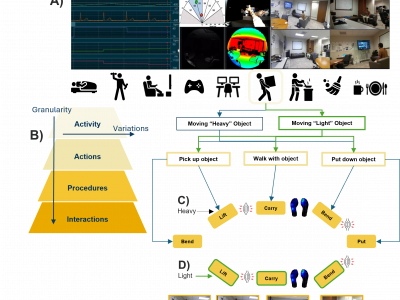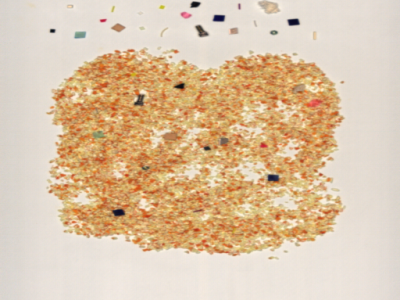Artificial Intelligence
The dataset consists of around 335K real images equally distributed among 7 classes. The classes represent different levels of rain intensity, namely "Clear", "Slanting Heavy Rain", "Vertical Heavy Rain", "Slanting Medium Rain", "Vertical Medium Rain", "Slanting Low Rain", and "Vertical Low Rain". The dataset has been acquired during laboratory experiments and simulates a low-altitude flight. The system consists of a visual odometry system comprising a processing unit and a depth camera, namely an Intel Real Sense D435i.
- Categories:
 199 Views
199 ViewsThe DARai dataset is a comprehensive multimodal multi-view collection designed to capture daily activities in diverse indoor environments. This dataset incorporates 20 heterogeneous modalities, including environmental sensors, biomechanical measures, and physiological signals, providing a detailed view of human interactions with their surroundings. The recorded activities cover a wide range, such as office work, household chores, personal care, and leisure activities, all set within realistic contexts.
- Categories:
 607 Views
607 Views
Latent fingerprint identification is crucial in forensic science for linking suspects to crime scenes. Latent examiners obtain unique, reliable evidence by revealing hidden prints through advanced techniques. However, latent fingerprints often are partial prints with undesirable characteristics such as noise or distortion. Due to these characteristics, identifying the physical details of a latent fingerprint, known as minutiae, is a complex task. Recent publications found that there are subsets on one minutia in latent fingerprints that, when removed, increase the matching score.
- Categories:
 165 Views
165 Views
Dataset from UCI contains the electricity consumption (in kWh) of 320 customers every 15 minutes from 2011 to 2014. For some customers, their electricity consumption data was recorded starting from a different time, and the data before the first record was marked as 0. As training model requires a starting point for the time series, and different customers have different starting times, some features remain 0 before a certain time point. Using all the data for training would inevitably have a negative impact. Therefore, the data from 2011 is removed and set the starti
- Categories:
 333 Views
333 Views
Study on Sleep Positions using a Wearable Device
This device constantly collects data about acceleration in three directions (tri-axial) 50 times a second (50 Hz). It has several components: a microcontroller for gathering and sending data (ESP8266), a battery (lithium-ion), a sensor for measuring acceleration (ADLX345 accelerometer), and a protective case made of plastic. The device can also store data temporarily on a microSD card in case the wireless connection is lost.
- Categories:
 176 Views
176 Views
The provided data package contains Livox LiDAR scan data from the Calar simulation platform, capturing scenarios in three distinct tunnels, each with various obstacles. The dataset includes LiDAR data recorded at different distances from the sensor, . Additionally, the data encompasses varying numbers of obstacles.
- Categories:
 107 Views
107 ViewsThe identification of rock fractures in strata is crucial to enhance the intelligence of rock detection. Traditional fracture feature extraction methods suffer from issues such as low accuracy and low processing speed, necessitating the development of more effective approaches. To address this problem, this study proposes a new fracture instance segmentation network called FracSeg. Based on the SOLOv2 framework, we incorporated the Swin Transformer to optimize the backbone network and enhance fracture feature extraction.
- Categories:
 169 Views
169 ViewsThis dataset consists of inertial, force, color, and LiDAR data collected from a novel sensor system. The system comprises three Inertial Measurement Units (IMUs) positioned on the waist and atop each foot, a color sensor on each outer foot, a LiDAR on the back of each shank, and a custom Force-Sensing Resistor (FSR) insole featuring 13 FSRs in each shoe. 20 participants wore this sensor system whilst performing 38 combinations of 11 activities on 9 different terrains, totaling over 7.8 hours of data.
- Categories:
 218 Views
218 ViewsHyperspectral imaging captures material-specific spectral data, making it highly effective for detecting contaminants in food that are challenging to identify using conventional methods. In the food industry, the occurrence of unknown contaminants is particularly problematic due to the difficulty in obtaining training data. This highlights the need for anomaly detection algorithms that can identify previously unseen contaminants by learning from normal data. This dataset is designed to test anomaly detection performance in normal data that contains impurities.
- Categories:
 23 Views
23 Views
The training trajectory datasets are collected from real users when exploring the volume dataset on our interactive 3D visualization framework. The format of the training dataset collected is trajectories of POVs in the Cartesian space. Multiple volume datasets with distinct spatial features and transfer functions are used to collect comprehensive training datasets of trajectories. The initial point is randomly selected for each user. Collected training trajectories are cleaned by removing POV outliers due to users' misoperations to improve uniformity.
- Categories:
 90 Views
90 Views



